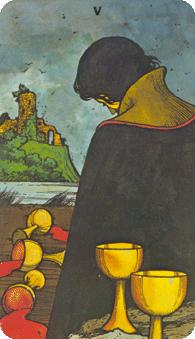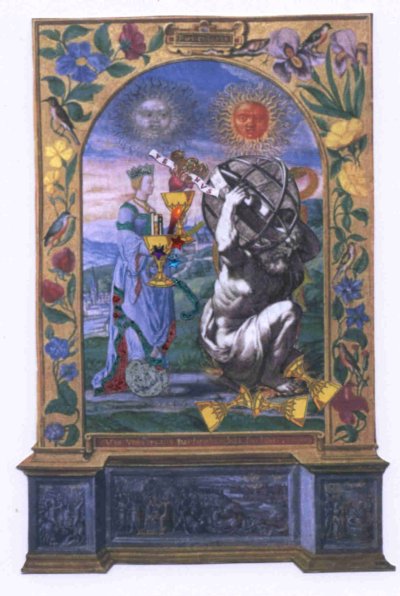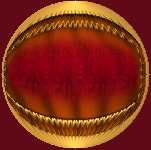5 of Cups: Tears In A Bottle
(c) Cheryl Lynne Bradley 2005-7

"If I could be anything, it'd be a tear to be born of your eye, live on your cheek, and die on your lips." - Author Unknown
"Tears are the strength of women."--St. Evremond
“Thou tellest my wanderings: put thou my tears into thy bottle: are they not in thy book?” - Psalm 56:8

The 5 of Cups is a card that always reminds me of sadness and spilled tears. A downcast and hooded figure looking back on spilled cups on the ground. He seems to have forgotten that liquids take the path of least resistance and nothing spilled is ever wasted, just taken back into the earth. He also has lost focus on the other cups, still full and waiting to be enjoyed. I think these are cups are full of all the tears we have ever shed, are shedding now and will shed in the future - they represent tears in a bottle, the distillation of our souls and the deepest bittersweet essence of sorrow.
In the Jewish tradition, the first tears were shed after Adam and Eve had been banished from the Garden of Eden. God realized that they were very contrite and distressed over the punishment He had meted upon them and offered them tears as a comfort to ease their burden in times of grief and crisis. Upon learning this Adam and Eve were overcome with sadness. The tears welled up in their eyes, rolled down their cheeks and fell to earth. Their tears of anguish moistened the earth. Tears became Adam and Eve's legacy. Whenver a human being is suffering, the tears begin to flow from his or her eyes and the gloom is lifted.
In Jewish mysticism, weeping was used to open a doorway to a visionary or mystical experience. In particular, falling asleep after weeping deeply opened the gates of the consciousness to a profound dream experience, apocalyptic vision and the Word of God. This was called mystical weeping and was widely practiced and taught.
To dream that you are in tears can indicate that a healing is taking place in your life. It may also be a warning of an approaching calamity. To dream that others are in tears can indicate that your sorrow will concern your friends. Seeing a teardrop in your dreams can represent previous wisdom you have learned and remembered. Hearing a baby crying in a dream can signify surprising good news but any other crying can indicate news of a friend or acquaintance in distress and to be sure to be sympathetic in your handling of the matter.
It is an old European superstition that a child who cries long will live long. Another old superstition warns us not to cry over someone who is dying or at the graveside of someone who has just passed over. The belief being that if tears fall on the person or in the grave, the soul will be robbed of its rest. Tears shed at weddings and baptism are taken as very happy omens. Pearls are often thought to symbolize tears and are viewed as unlucky. They were to be particularly avoided by brides.
Tear bottles or lachrymatories have been a mourning tradition utilized by many cultures. The reference in Psalm 56:8 was written 1,000 years before Christ and lachrymatories were found in the tombs of the ancient Egyptians and other Middle East cultures. Tear bottles were also popular with the Romans during the time of Christ. Mourners would fill small glass bottles or cups with tears. They were placed in the burial tombs as a sign of respect. It was not uncommon for women to be paid to fill these bottles or cups with their tears as they walked in the funeral procession. The more copious the tears and the louder the wail, the better the pay and greater the reverence was perceived to be for the recently departed.
Tear bottles made a resurgence during the Victorian Era when the mourners would collect their tears in ornately decorated bottles with stoppers to prevent evaporation. Tear bottles were also very popular during the Civil War. Wives waiting for their husbands would collect their tears and preserve them until their husbands came home from the war. They are widely available today and are really quite a beautiful and unique way to honour a soul that has passed over.
We have all shed tears of of many varieties. We shed tears for laughter, grief, loss, longing, anger, futility, compassion, shame, disappointment, success, failure, regret, joy, gratitude, loneliness, heartache, contrition, fear, pride, relief, concern, rejection, abandonment, humiliation, distress, desperation, horror, indecision, meeting and separation. We cry at births, weddings, funerals, school concerts, graduations, birthdays, anniversaries - tears are an all occasions fashion accessory. Once you have children, your bladder officially moves behind your eyes. Our tears are more associated with our personal distresses and joyful emotions than with injury or allergy.
Human beings are the only living creatures that are able to laugh and able to shed tears to express and release our emotions. Our eye doctors will tell us that our tears are a lubricating fluid which prevents the eyeball from becoming dry. If you analyzed a tear chemically, you would find it is a solution made up mostly of sodium chloride and calcium. We all know that there is so much more to our tears than mere lubrication and physiology.

















